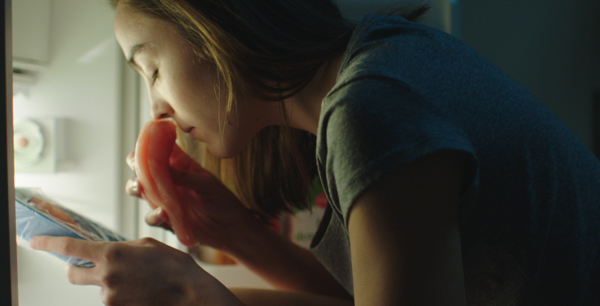Movie review by Greg Carlson
A sinewy, blood-drenched feast of old fashioned gore and fresh storytelling, first-time feature writer-director Julia Ducournau’s “Raw” is the cannibal horror comedy you never knew you needed. Made with a level of confidence not seen in filmmakers with half a dozen completed movies, “Raw” builds a wholly engrossing and fully functioning universe in which to contain its walloping frights and freak-outs. Ducournau explores several juicy themes without shortchanging any one of them: sisterhood and sibling rivalry, sexual awakening and female pleasure, parental expectation and influence, peer pressure and conformity, and the moral conundrum of the carnivore.
Justine (Garance Marillier), a whip-smart, head-of-the-class overachiever, enrolls at the veterinary school attended by older sis Alexia (Ella Rumpf). Mom (Joana Preiss) and Dad (Laurent Lucas) are graduates of the same program, and the strict vegetarianism practiced by the family is one of the first obstacles faced by Justine when the incoming students are mercilessly hazed by upperclassmen. Coerced into ingesting uncooked rabbit kidney as part of one initiation, Justine rapidly develops a taste for flesh that won’t be satisfied by hasenpfeffer.
But instead of focusing narrative attention solely on Justine’s insatiable appetite and its inevitable consequences, Ducournau ups the ante by ambitiously dropping the viewer in the heart of the utterly disorienting space occupied by the world’s most hedonistic animal science academy. Drug-fueled, all-night raves are dizzy, sweaty, underwear optional laboratories for the sleep-deprived recruits who somehow stumble to morning classes. Faculty members appear onscreen, but no authority figures seem concerned about the marauding seniors who trash dormitories at will, tossing mattresses, suitcases, and anything else not nailed down out the nearest windows.
While we try to make sense of the incongruity of a presumably accredited institute of higher learning and the decadent behavior of its student body, Ducournau escalates a series of increasingly tense set pieces to an absolutely woozy fever pitch. If the thought of a Brazilian wax gone sideways gives you pause, Ducournau is just getting warmed up. The film’s practical effects are superb in their anatomical verisimilitude, and the director’s sense of tone is as on point as the work of Bob Balaban in “Parents” and Claire Denis in “Trouble Every Day.”
Scheduled for an American theatrical release in March of 2017, “Raw” deserves a rapid ascent to cult status, midnight screenings, and an eventual spot as a must-see that devotees will spring on unsuspecting friends just to gauge reactions. Echoing the hyperbolic stratosphere of William Castle-style showmanship, “Raw” reportedly caused at least two viewers to faint at a Toronto exhibition. I did not witness any passing out at the Sundance Film Festival showing I attended, but Ducournau’s fireworks were met with verbal exclamations, covered or averted eyes, and plenty of squirming.
Metaphorically speaking, “Raw” comfortably operates on several levels. As a feminist bildungsroman, its commentary on the challenges of finding one’s way through the liminal space between adolescence and adulthood is every bit as satisfying as a political reading (in her Sundance introduction, Ducournau had some choice words for the newly elected leader of the United States and his well-publicized attitude regarding sexually desirable young women). “Raw” lives up to the hype, sticking to you like the geysers of crimson plasma that color Justine’s bruised and lacerated world.
